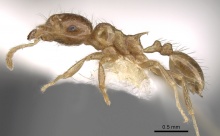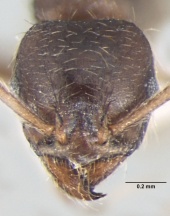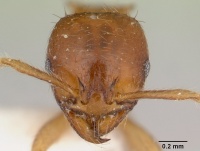Key to Lophomyrmex species
This key to Lophomyrmex species is based on Rigato (1994[1]) with the bedoti group updated by Bharti & Kumar (2012[2]).
1
- In dorsal view, the anterior angles of pronotum with two distinct flattened horizontal teeth or spines directed anterolaterally (quadrispinosus group) => 8
- In dorsal view, pronotum with lateral irregular marginations only (bedoti group) => 2
2
- SI ≥ 100, SpL ≥ 0.34 mm. Pronotum in frontal view without a pair of anterior erect setae near the midline; mesonotum in profile at most with a few thin, short, oblique hairs (Brunei, E. Malaysia) => Lophomyrmex longicornis
- SI < 100, SpL < 0.34 mm. Pronotum in frontal view with a pair of anterior erect setae near the midline; mesonotum in profile with standing coarse hair => 3
3
- Smooth and shiny; only the upper portion of themesopleuron clearly reticulate. TL < 2.8 mm (W. Malaysia) => Lophomyrmex lucidus
- The majority of the mesothorax and propodeum with distinct reticulation. TL often > 3 mm => 4
4
- Sculpture less developed; pronotal sides and head surface behind and below the eyes shiny or at most faintly sculptured. Eyes smaller and in lateral view the distance between their anterior margin and the mandibular insertion is ≥ 1.5 times the maximum eye length. Propodeal spines in lateral view thinner, appearing longer and very straight. Petiolar node clearly obliquely truncate: the steep anterior face and the flat dorsum meeting at a distinct, sometimes slightly protruding, angle (Sri Lanka, India, Burma, Malaysia, Singapore, Brunei, Indonesia, Philippines) => Lophomyrmex bedoti
- Sculpture more developed: pronotal sides or head surface behind and below the eyes always at least superficially sculptured, not fully shiny. Eyes larger and in lateral view the distance between their anterior margin and the mandibular insertion is usually < 1.5 times maximum eye length. Propodeal spines in lateral view more gradually narrowing towards their tips or thick and blunt along their entire length and appearing shorter and not very straight. Petiolar node either somewhat rounded or truncate => 5
5
- On lateral view the pronotum costulate with at least one longitudinal anterior, short costula running backward from the insertion of the humeral seta. In full-face view head usually more clearly rugulose in the space between the inner margin of the eyes and the frontal lobes (the rugulae are more easily visible in oblique view) (Thailand) => Lophomyrmex striatulus
- On lateral view the pronotum is not longitudinally costulate; no costulae running backward fromthe insertion of the humeral seta. Head either with or without rugulae in the space between the inner margin of the eyes and the frontal lobes => 6
6
- Propodeal spines very long (SpL 0.26 mm, SpLI 36.11 mm); distance between eyes and base of mandibles 1.2 times eye length; 3 or 4 pairs of setae on head, mesosoma and pedicel (India) => Lophomyrmex changlangensis
- Propodeal spines short (SpL 0.20–0.24 mm, SpLI 30.00–33.80 mm); distance between eyes and base of mandibles 1.3 times eye length; numerous hairs on head, mesosoma and pedicel => 7
7
- Head usually without rugulae in the space between the inner margin of the eyes and the frontal lobes. Petiolar node somewhat rounded, propodeal spines pointed (India, Nepal) => Lophomyrmex ambiguus
- Head with rugulae in the space between the inner margin of the eyes and the frontal lobes. Petiolar node clearly obliquely truncate, propodeal spines thick, blunt, sub-parallel, and of almost uniform diameter (India) => Lophomyrmex terraceensis
8
- Pronotum with teeth that only slightly protrude. In dorsal view their anterior margins are approximately at a right-angle to the body axis or even faintly convergent anteriorly; their outer edges are straight or very weakly concave; the teeth do not look suddenly narrowed near their apices => 9
- Pronoturn with spiniform teeth that distinctly protrude. In dorsal view their anterior margins are moderately to markedly divergent airteriorly; if moderately, then their outer edges are often clearly concave and the teeth have a narrower apex => 10
9
- SI < 84. HL often >0.80. Pronotal teeth more or less sharp in dorsal view. Mesonotun, propodeun, petiole and postpetiole distinctly reticulate. Propodeal spines slightly down-curved. Postpetiole shorter than the petiole in lateral view. (Sri Lanka, India, Burma) => Lophomyrmex quadrispinosus
- SI >84, HL < 0.80. Pronotal teeth blunt in dorsal view. Mesonoturn, propodcum, petiole and postpetiole faintly sculptured. Propodeal spines straight. Postpetiole massive, approximately as long as the petiole in lateral view (Taiwan) => Lophomyrmex taivanae
10
- SI and TI = 100. Propodeal spines slightly upcurved in profile (India) => Lophomyrmex kali
- S1 and TI < 100. Propodeal spines straight or feebly down-curved in profile => 11
11
- Pronotal spines strongly diverging anteriorly and with longer, sharper tips. More sculptured species: at least mesothorax, propodcum, petiole and postpetiole clearly reticulate; often dorsum of head and pronotum longitudinally rugulose. Postpetiole distinctly shorter than the petiole (Java) => Lophomyrmex opaciceps
- Pronotal spines neithcr so divergent nor with such long and sharp tips. Less sculptured: mesonoturn and nodes of petiole and postpetiole not wholly and clearly reticulate; head always shining. Postpetiole nearly as long as the petiole (Sri Lanka, Burma, Thailand) => Lophomyrmex birmanus
References
- ↑ Rigato, F. 1994. Revision of the myrmicine ant genus Lophomyrmex with a review of its taxonomic position (Hymenoptera: Formicidae). Systematic Entomology, 19, 47–60.
- ↑ Himender Bharti & Rakesh Kumar. 2012. Lophomyrmex terraceensis, a new ant species (Hymenoptera: Formicidae) in the bedoti group with a revised key. Journal of Asia-Pacific Entomology, 15, 265–267.



















